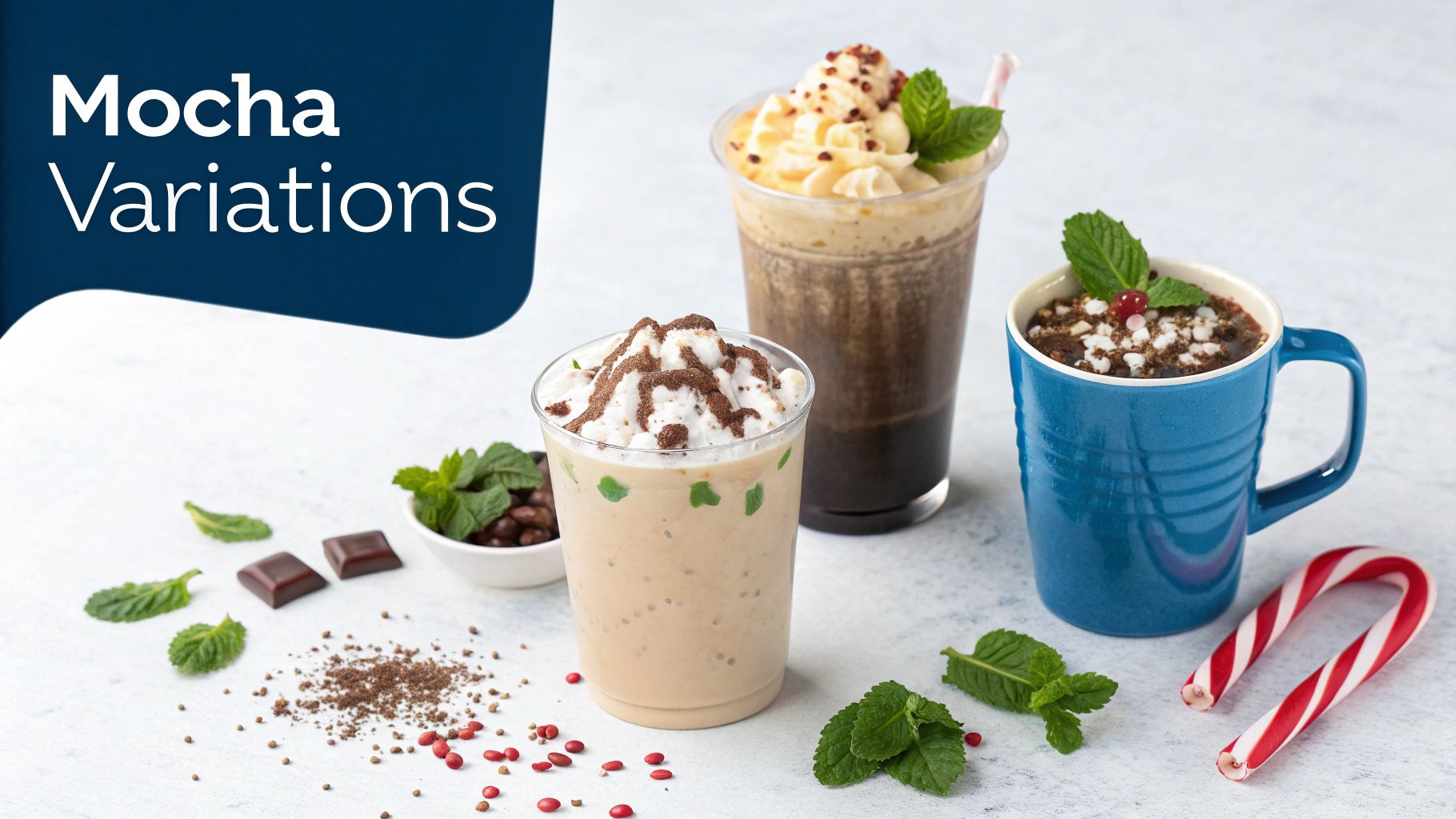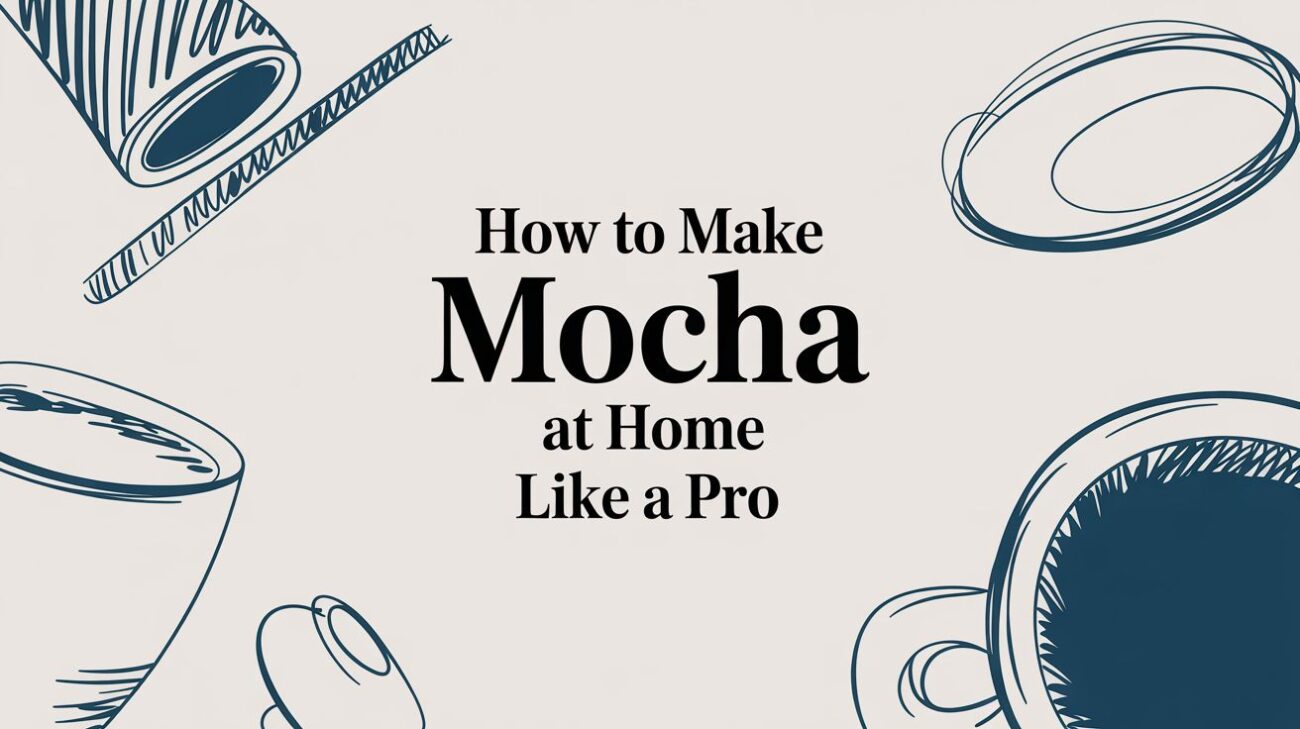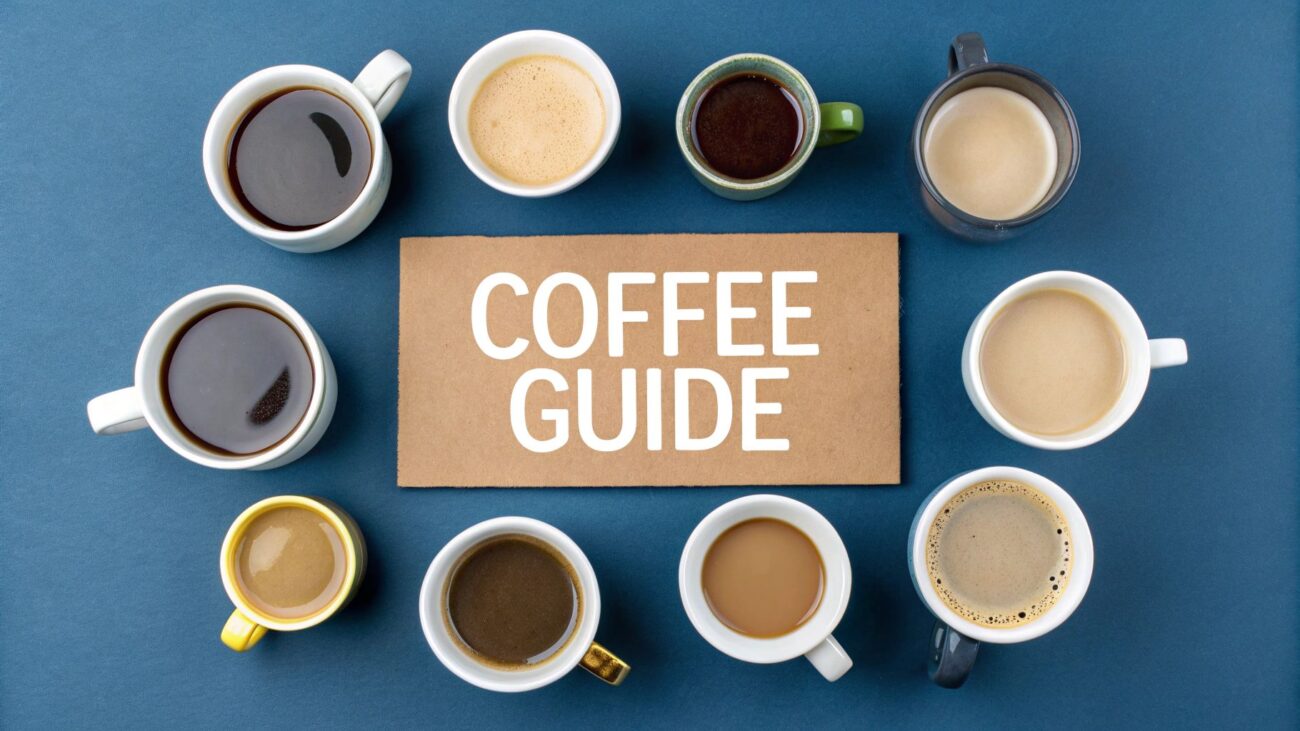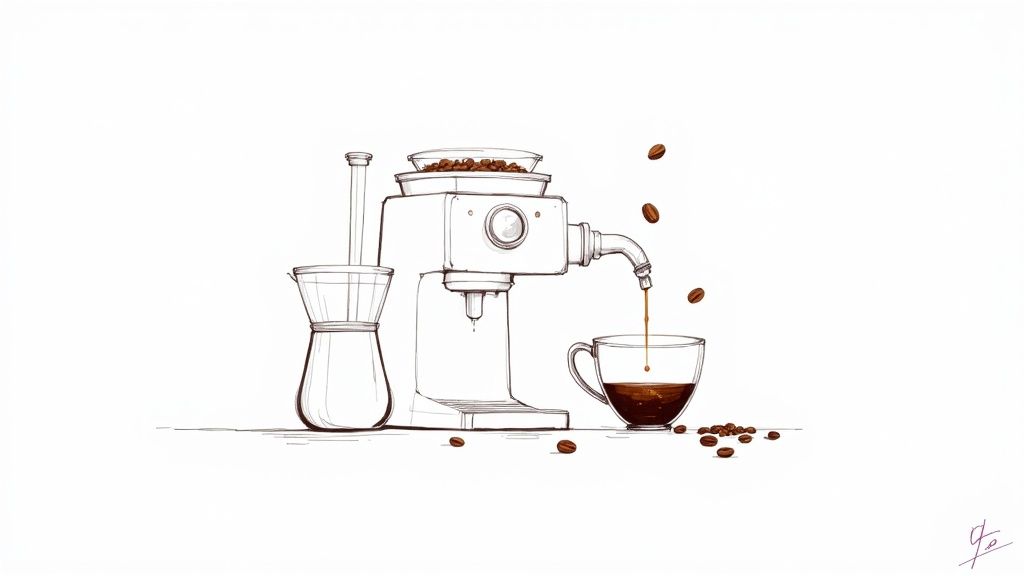How to Make a Mocha at Home Like a Barista
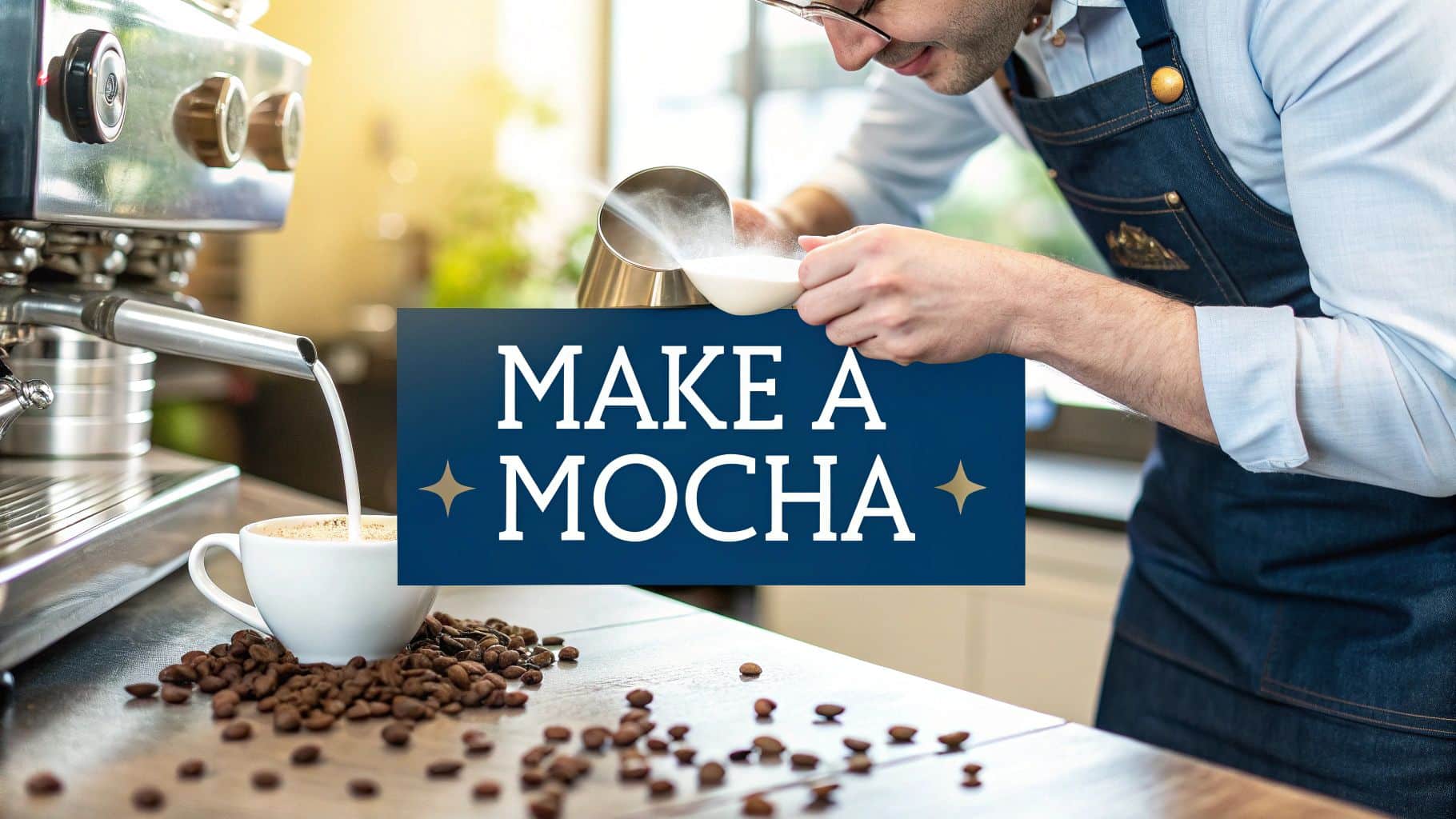
Making a mocha at home is surprisingly simple. At its heart, it’s just a beautiful combination of strong coffee or espresso, your favourite chocolate, and steamed milk.
Think of it as a hot chocolate that’s grown up and got a sophisticated, caffeinated kick. It truly is the best of both worlds in one comforting mug, and this guide will walk you through creating the perfect one from scratch.
The Enduring Allure of the Mocha
A mocha is so much more than just another drink on a café menu; it's a comforting ritual, a cornerstone of modern coffee culture. This perfect marriage of rich coffee and decadent chocolate has cemented its place as a favourite for anyone looking for a gentle introduction to coffee or just a sweet, energising treat.
But where did this beloved drink actually come from, and why does it remain so popular?
Its origins are often traced back to the Yemeni port city of Mocha, which was a powerhouse in the coffee trade for centuries. While the original coffee from this region didn't actually have chocolate in it, the name became synonymous with high-quality beans known for their naturally chocolatey tasting notes. Over time, the name "mocha" was adopted for the drink we know and love today, blending espresso with chocolate to echo those delightful flavours.
A UK Coffee Shop Favourite
Here in the UK, the mocha's popularity is a real testament to our ever-evolving coffee habits. As a nation, we now get through around 98 million cups of coffee every single day, with a huge number of us visiting coffee shops on the regular.
This growing appreciation for speciality coffee has cemented the mocha as a go-to choice, perfectly bridging the gap between a classic latte and a luxurious hot chocolate. If you dive into the UK's coffee shop culture, you'll quickly see why this drink is such a staple.
The real beauty of learning how to make a mocha is the freedom it gives you. You become the barista, choosing the intensity of the coffee, the richness of the chocolate, and the creaminess of the milk to create a drink that is uniquely yours.
From picking the right coffee beans to mastering the perfect grind size—a crucial step for flavour which you can learn all about in our comprehensive coffee grind size guide—every choice you make matters. This guide is designed to give you the know-how to craft a mocha that rivals, and maybe even beats, the one from your favourite café.
Choosing Your Core Mocha Ingredients
The secret to a truly exceptional mocha isn't some complicated, barista-only technique. It’s all about the quality of the three core ingredients. Think of it as a perfectly balanced trio where the coffee, chocolate, and milk each play a crucial role. Nailing this foundation is what separates a decent mocha from an unforgettable one.
It all starts with the coffee. Because you're adding rich chocolate and creamy milk, your coffee needs to have enough character to hold its own. A light, delicate roast will just get lost in the mix, leaving you with something that tastes more like a weak hot chocolate than a proper mocha.
Selecting Your Coffee and Chocolate
For that robust base, you really want a medium-to-dark roast. These roasts bring the deep, bold flavours needed to stand up to the sweetness of the chocolate. You’ll often find their natural notes of caramel, nut, or even dark chocolate create a perfect harmony. If you’re pulling shots on an espresso machine, getting the beans right is paramount. You can explore some of our top picks for the best coffee beans for an espresso machine to get started.
When it comes to the chocolate, you’ve got a few fantastic options, and each one changes the final taste and texture:
- Real Dark Chocolate: For a truly decadent, rich flavour, you can't beat finely chopped or shaved dark chocolate (around 70% cacao). It melts beautifully into the hot espresso, creating a luxurious, full-bodied sauce from scratch.
- Unsweetened Cocoa Powder: This gives you complete control over the sweetness. A high-quality cocoa powder provides a deep, earthy chocolate punch without any added sugar, letting you sweeten the drink exactly how you like it.
- Chocolate Syrup: This is easily the most convenient option as it dissolves instantly. While it's handy, just be mindful that many commercial syrups are incredibly sweet. You might want to start with less than you think you need and add more to taste.
Finding the Right Milk
Finally, the milk is what gives your mocha its creaminess and texture. Whole milk is the classic choice because its higher fat content creates that rich, velvety microfoam when you steam it. That said, plant-based alternatives can be absolutely wonderful, too.
Oat milk is a firm favourite for many as it froths almost as well as dairy and adds a lovely, creamy body. Almond milk is a lighter option, but make sure you grab a ‘barista’ version specifically designed for frothing if you want to get the best results.
The perfect mocha isn't about rigid rules; it's about what you enjoy. Don't be afraid to experiment with different chocolate types and milk-to-coffee ratios to find the combination that makes you happiest.
To give you a solid starting point, we've put together our go-to measurements for a single, perfectly balanced mocha. This table breaks down the ideal ratios whether you're using an espresso machine or another strong coffee method.
Perfect Mocha Ingredient Ratios Per Serving
| Ingredient | Espresso Machine Method | Moka Pot or Instant Method |
|---|---|---|
| Coffee | 1 double shot espresso (approx. 60ml) | 60ml of very strong coffee |
| Chocolate | 20-25g dark chocolate or 1 tbsp cocoa | 20-25g dark chocolate or 1 tbsp cocoa |
| Milk | 180ml milk of your choice | 180ml milk of your choice |
| Sweetener | To taste (optional) | To taste (optional) |
These measurements are a great baseline, but feel free to tweak them until your mocha is exactly how you love it.
The Barista Method Using an Espresso Machine
If you're chasing that authentic, coffee-shop-quality mocha, your espresso machine is about to become your best friend. This is the method that gives you total control over every single element, from the punch of the coffee to the silky texture of the milk. It’s all about building the drink in layers to get a truly superior result.
First things first, you need to pull a perfect double shot of espresso. This is the heart and soul of your mocha, so getting it right is non-negotiable for a rich, balanced flavour. A great shot should be syrupy and intense with a beautiful, stable crema on top—never watery or harsh. If you want a deep dive into nailing your technique, our guide on how to make an espresso at home is a fantastic place to start.
Creating the Perfect Chocolate Base
With your espresso ready and waiting, it’s time to build that decadent chocolate foundation. This is the moment your coffee starts its transformation into a mocha, and the trick is to mix your chocolate directly into the hot espresso while it's still fresh in the mug.
Whether you’re using finely shaved dark chocolate or a quality cocoa powder, the heat from the fresh espresso is exactly what you need to melt and dissolve it perfectly.
- For Chocolate Shavings: Pop them in the mug first, then pour the hot espresso directly over the top. Let it stand for about 30 seconds before stirring until you have a smooth, glossy chocolate-espresso sauce.
- For Cocoa Powder: Sieve the powder into your mug before pulling the shot. This simple step gets rid of any annoying clumps and makes it much easier to mix into a smooth paste.
This creates a flawless base sauce, ensuring the chocolate is fully incorporated and you avoid any gritty texture in the final drink.
This visual guide breaks down just how simple it is to bring these high-quality components together for a classic mocha.
As you can see, a truly great mocha depends on the harmony between just three core elements: coffee, chocolate, and milk.
Mastering Steamed Milk
Once your base is ready, the final flourish is the steamed milk. This is arguably the most crucial skill for achieving that genuine café-quality mocha at home. The goal here is microfoam—a velvety, silky texture where the milk is aerated just enough to become creamy and pourable, not stiff and bubbly like you'd find on a cappuccino.
Pour cold milk into your metal jug, filling it to just below where the spout begins. Dip the steam wand tip just beneath the surface and switch it on. You're looking for a gentle hissing sound as you introduce air.
Pro Tip: Don't stick the steam wand right in the middle of the jug. Position it slightly off-centre to create a vortex, or whirlpool. This motion is key to breaking down larger air bubbles and folding the air in for that silky-smooth microfoam.
As soon as the jug feels warm to the touch (about the same temperature as your hand), plunge the wand deeper into the milk. This stops the aeration process and just heats the milk through. When the jug gets too hot to hold comfortably, you’re done. The milk should look glossy, almost like wet paint.
Now for the final pour. Start high, letting the liquid milk cut through and combine with the chocolate-espresso base. Then, bring the jug lower to the mug to pour the creamy foam on top, creating a little art if you fancy it. All that's left is to sit back and savour your perfectly crafted, homemade mocha.
Making a Mocha Without an Espresso Machine
Let's be honest, not everyone has a fancy espresso machine hogging their kitchen counter. But that shouldn't stop you from enjoying a genuinely rich, satisfying mocha at home. You can absolutely nail that deep coffee flavour without the high-end gear.
This is the reality of how most of us make coffee. In the UK, we get through an astonishing 35,770 million cups of coffee a year, but our brewing methods are all over the place. While coffee shops live and die by their espresso machines, around 80% of UK households still buy instant coffee, showing a clear preference for convenience. This is exactly why knowing how to whip up a mocha with simpler tools is so valuable. You can read more about UK coffee consumption patterns on balancecoffee.co.uk.
So, let's dive into two brilliant ways to build that essential coffee base, no espresso pods required.
The Stovetop Moka Pot Method
The moka pot is a classic for good reason. This little stovetop wonder produces a short, concentrated, and intensely flavoured coffee that’s the closest you'll get to a true espresso shot. It uses steam pressure to push water up through the coffee grounds, creating a rich and syrupy brew that stands up beautifully to chocolate and milk.
To get the best results and avoid that common pitfall—a burnt, metallic taste—just follow these simple tips I've learnt over the years:
- Use Warm Water: Start by filling the bottom chamber with hot, but not boiling, water. This cuts down the time the pot spends on the heat, which is key to preventing the coffee grounds from scorching.
- Watch the Heat: Pop it on a low-to-medium heat. You’re aiming for a steady, gentle flow of coffee, not a volcanic eruption.
- Listen Carefully: The moment you hear a gurgling, sputtering sound, take it off the heat immediately. That noise is your cue that the water's gone and you're now just pushing bitter-tasting hot steam through.
This method gives you a brilliant 60ml base for your mocha. For other ways to get a strong brew, you might be interested in our guide on how to use an AeroPress, another excellent tool for concentrated coffee.
The Strong-Brew Alternative
If you don't have a moka pot, don't worry. You can still craft a delicious mocha using a French press or even some high-quality instant coffee. The mission remains the same: create a small amount of very strong coffee.
For a French press, just double your usual coffee-to-water ratio. I find that using two heaped tablespoons of coarsely ground coffee for just 100ml of hot water works perfectly. Let it steep for the usual four minutes before plunging.
With instant coffee, the trick is simply to use less water. Mix two teaspoons of a good-quality instant coffee with about 60-80ml of hot water. Stir until it's completely dissolved, and you'll have a potent coffee concentrate ready to go.
No matter which method you choose, intensity is everything. You need a coffee base strong enough to complement the chocolate and milk, not get lost in them.
Frothing Milk Without a Steam Wand
Creating lovely frothy milk at home is surprisingly easy, and you definitely don't need a steam wand.
One of the simplest ways is with a handheld frother. These little battery-operated whisks are cheap and incredibly effective. Just warm your milk in a pan or the microwave, then submerge the frother and let it run for 20-30 seconds until you have a nice, creamy foam.
Alternatively, the jar method works a treat. Pour warm milk into a clean, sealable jar, but don't fill it more than halfway. Screw the lid on tight and shake it like you mean it for about 30-45 seconds. The milk will double in volume and create a perfectly good foam for your homemade mocha.
Creative Mocha Variations to Try at Home
Once you’ve nailed the classic homemade mocha, you’ve unlocked a whole world of delicious possibilities. The core recipe is a fantastic canvas for creativity, allowing you to tweak and transform it for any season, mood, or dietary need. From a refreshing summer cooler to a cosy winter warmer, these variations are simple to make and incredibly satisfying.
Think of it as moving beyond the standard hot chocolate and coffee combo. Exploring different flavours and techniques is genuinely part of the fun of being your own barista. If you want to dive even deeper into the world of coffee creations, you can check out our guide on different types of coffee drinks for even more inspiration.
Cool Down with an Iced Mocha
When the weather warms up, an iced mocha is the perfect treat. The real challenge, though, is chilling the drink without diluting that rich, bold flavour we worked so hard to create. Simply pouring hot coffee over ice is a recipe for a watery, disappointing drink.
Here’s the right way to do it:
- Prepare in Advance: Brew your double shot of espresso or strong coffee and let it cool completely. I usually pop it in the fridge for at least an hour to make sure it's properly chilled.
- Make the Chocolate Base: Mix your chocolate syrup or melted chocolate with the cooled coffee until it's perfectly smooth.
- Assemble with Care: Fill a tall glass with ice, pour over your chocolate coffee mixture, and then top it up with cold milk. Give it a gentle stir and enjoy immediately.
Indulgent Twists for Any Occasion
For something a little different, why not switch up the chocolate? These two popular variations offer unique flavour profiles that are perfect for special occasions or just when you fancy a change.
White Chocolate Mocha: For a sweeter, creamier experience, simply substitute the dark chocolate with 25g of high-quality white chocolate. Melt it into the hot espresso just as you would with dark chocolate for a truly luxurious and velvety drink.
Peppermint Mocha: This festive favourite is perfect for the holiday season. Just add ¼ teaspoon of peppermint extract to your standard mocha recipe along with the chocolate. It creates a wonderfully nostalgic, warming flavour combination that’s hard to beat.
Creating a Delicious Vegan Mocha
Making a superb plant-based mocha is easier than ever, thanks to the fantastic range of dairy-free milks and chocolates available. The process is identical, but your choice of ingredients really makes all the difference.
Oat milk is often the top choice as it froths beautifully and has a creamy texture that mimics dairy milk. For the chocolate, use a high-quality dark chocolate that's certified vegan or a dedicated plant-based chocolate syrup.
This shift towards plant-based and ethical choices is becoming more and more important. You can see how sustainability concerns are influencing mocha production; the UK market shows a rising demand for traceable, organic coffee beans and ethical chocolate, especially among younger drinkers. This trend pushes cafes and home baristas alike to adopt more environmentally conscious practices, from bean to cup. If you're keen to explore other beverage ideas, there's a whole world of creative drinks to discover beyond coffee.
Got a Question About Your Mocha?
As you get closer to mastering the perfect homemade mocha, it’s only natural for a few questions to pop up. Think of me as your friendly barista, ready to help you sort out any tricky bits and get your technique just right.
Honestly, getting the hang of a great mocha is all about understanding how the key players—coffee, milk, and chocolate—work together.
What’s the Difference Between a Mocha and a Latte?
The one glorious, indulgent difference is chocolate. A latte is that classic, elegant pairing of espresso and steamed milk. A mocha takes that exact formula and invites a rich chocolate element to the party, making it a delicious middle ground between a proper coffee and a hot chocolate.
It’s this addition of chocolate—whether you’re using a syrup, cocoa powder, or shavings of the real stuff—that gives the mocha its signature sweet and decadent character.
How Do I Stop My Mocha from Tasting Bitter or Too Sweet?
Finding that perfect sweet spot comes down to having a handle on your ingredients and your brewing. A bitter mocha is almost always a sign that your coffee was over-extracted. This usually means the water was too hot or it spent too much time with the grounds. Just be mindful of your brewing time and you should be golden.
As for the sweetness? The fix is simple: taste as you go.
By using unsweetened cocoa powder or a quality dark chocolate, you’re starting from a neutral, flavourful base. You can then add sugar or syrup a little at a time, giving you total control over the sweetness. Pre-made syrups can easily overwhelm the drink, so this method puts you in the driver's seat.
This way, you can tailor the mocha precisely to what you fancy.
Can I Make a Mocha Without an Espresso Shot?
Absolutely. While a traditional mocha gets its punch from an intense espresso shot, you can whip up a fantastic version using a strong coffee concentrate. The aim is to brew a coffee that's much more potent than your average morning mug.
Here are a few brilliant ways to do it:
- Moka Pot: This little stovetop hero brews a rich, syrupy coffee that gets you incredibly close to espresso in strength.
- AeroPress or French Press: Just up the ratio of coffee grounds to water to create a really concentrated brew.
- Instant Coffee: Don't write off a good quality instant! Simply dissolve it in a much smaller splash of hot water to create a powerful, espresso-like base.
What Is the Best Type of Chocolate for a Mocha?
The "best" chocolate is completely down to your personal taste. For a deep, complex flavour, you really can't beat a high-quality dark chocolate with at least 70% cacao. A good unsweetened cocoa powder also works beautifully when melted directly into the hot espresso.
Chocolate syrup is obviously the most convenient option because it dissolves instantly, but just keep an eye on its sweetness. If you're after something creamier and a bit sweeter, white chocolate is a wonderful choice. My rule of thumb is to use a chocolate you'd happily eat on its own—if you love the flavour, it’s going to shine in your mocha.
Ready to put all this knowledge into practice? A truly great mocha starts with exceptional coffee. At Seven Sisters Coffee Co, we source and roast our beans to bring out the very best in every cup, giving you the perfect foundation for your chocolatey creations.
Explore our range of ethically sourced, artisan-roasted coffee beans today and take your homemade mocha from good to unforgettable. Visit Seven Sisters Coffee Co to find your perfect brew.



